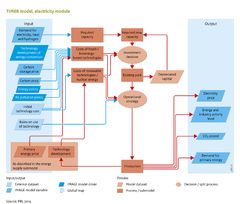Energy conversion/Policy issues: Difference between revisions
Jump to navigation
Jump to search
No edit summary |
No edit summary |
||
| Line 10: | Line 10: | ||
Model analyses show that a high proportion of emission reductions would be achieved through supply side changes. The capacity for different supply-side options under the baseline scenario and various pathways consistent with the 2 °C climate change target are presented in the figure below. | Model analyses show that a high proportion of emission reductions would be achieved through supply side changes. The capacity for different supply-side options under the baseline scenario and various pathways consistent with the 2 °C climate change target are presented in the figure below. | ||
The proportion of unabated fossil fuel use is still 80% of total primary energy under the baseline scenario (see above) but by 2050, this would need to be around 15 to 20% according to the 2 °C scenarios. The results show that pathways can be identified in which the remaining energy comes from bioenergy, other renewable energy, nuclear energy, and from fossil-fuel energy combined with {{abbrTemplate|CCS}}. There is flexibility in the choice of these options, as illustrated in the Decentralised Solutions and Global Technology pathways with different patterns for nuclear power and renewable energy. In the IMAGE framework under nearly all scenarios, the combination of bioenergy and CCS | <div class="version changev31"> | ||
The proportion of unabated fossil fuel use is still 80% of total primary energy under the baseline scenario (see above) but by 2050, this would need to be around 15 to 20% according to the 2 °C scenarios. The results show that pathways can be identified in which the remaining energy comes from bioenergy, other renewable energy, nuclear energy, and from fossil-fuel energy combined with {{abbrTemplate|CCS}}. There is flexibility in the choice of these options, as illustrated in the Decentralised Solutions and Global Technology pathways with different patterns for nuclear power and renewable energy. In the IMAGE framework under nearly all mitigation scenarios, the combination of bioenergy and CCS plays a critical role in achieving the 2 °C target. | |||
</div> | |||
}} | }} | ||
Revision as of 17:32, 9 November 2016
Parts of Energy conversion/Policy issues
| Component is implemented in: |
|
| Related IMAGE components |
| Projects/Applications |
| Models/Databases |
| Key publications |
| References |
